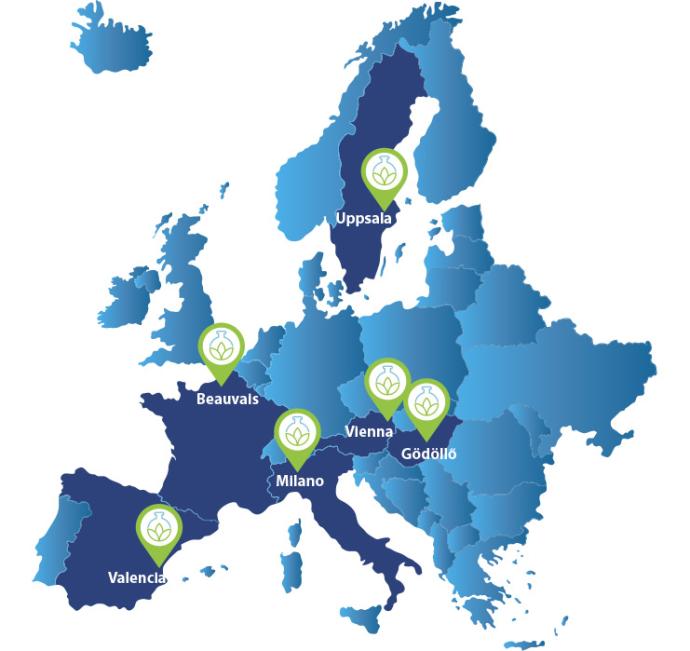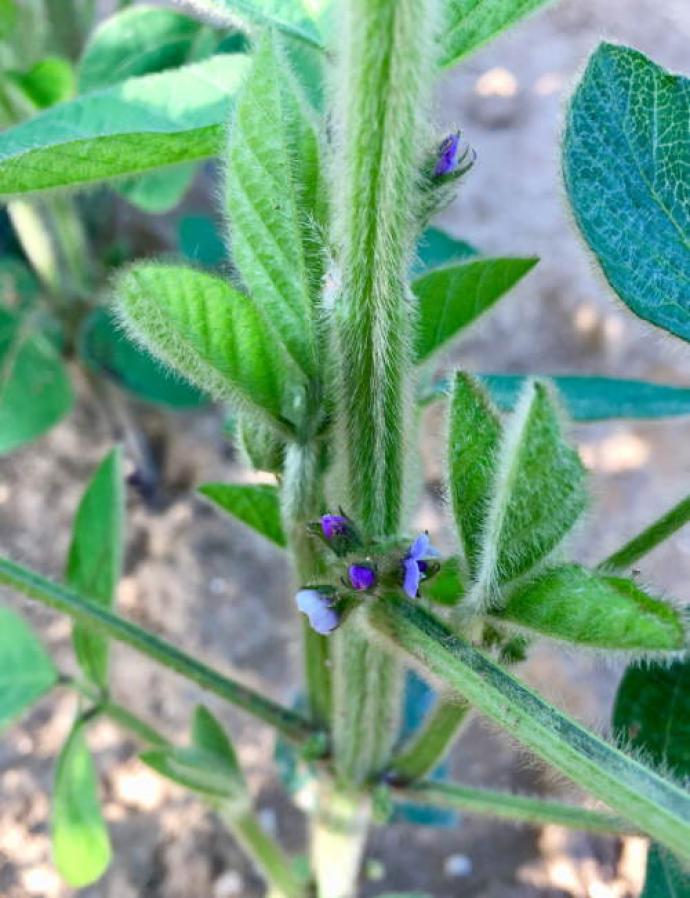Created in 2017, the Plant Breeding Chair has two objectives:
- to train field breeders capable of integrating biotechnologies and market understanding into their profession through a master's degree in plant breeding.
- to develop research axes on the following themes :
- the integration of new technologies to plant improvement ;
- the study from the epistemological and sociological point of view of the acceptability of innovation in plant breeding.
On the training side
The Erasmus Mundus Master in Plant Breeding
In June 2017, the European community granted the Erasmus Mundus label to the Master Plant Breeding, under the name emPLANT, Erasmus Mundus Program in Plant Breeding recognizing the originality and excellence of the proposed course. In 2021, this Master's degree was again accredited under the name emPLANT+ for the period 2020-2026.
It is now the only European Erasmus Mundus Master's program dedicated to plant breeding.
Thanks to this international recognition, in 2021, 530 candidates from all over the world have applied for this master's degree. Among the students selected, 22 Erasmus scholarship holders will start their studies at UniLaSalle in September 2022, in addition to 4 non-scholarship holders.

It was built in partnership with 6 universities:
- Institut Polytechnique UniLaSalle, France (ULS)
- Hungarian University of Agriculture and Life Sciences, Hungary (MATE)
- Swedish University of Agricultural Sciences, Sweden (SLU)
- University of Natural Resources and Life Sciences – Vienna, Austria (BOKU)
- Università Degli Studi di Milano, Italy (UMIL)
- Universitat Politècnica de València, Spain (UPV)
On the research side
The "Plant Breeding" chair has started a program focused on the study and understanding of genotype/environment interactions through ecophysiological models of growth and development, thus allowing a better understanding of the factors influencing plant adaptation.
Today, thanks to the greater availability of climatological data, we are able to better predict the contrasting reactions of genotypes to various climatic scenarios described by crop models and thus significantly impact genetic progress.
This program has chosen to use adapted and non-adapted legumes as model plants.
The societal side aims to study varietal innovation and specifically the integration of biotechnologies upstream and during the selection process, considering innovation as a sociotechnical process.

- The Chair's project focuses on three levels of crop plant interaction:
- The reaction of the plant to a stress, whether biotic or abiotic;
- The adaptation of the plant to the environment in its globality and variability;
- The perception by society of the improved and selected plant.
- Plant/stress interaction
- Plant/environment interaction
- Plant/society interaction
Plant/stress interaction
The "plant/stress interaction" (IPSt) program is interested in the reaction mechanisms of the plant subjected to biotic and abiotic stresses and more specifically in quantitative resistance mechanisms considered as more durable.
Concerning biotic stresses, the Chair is well positioned on the stimulation of plant defenses especially against cereal diseases such as septoria.
Concerning abiotic stresses, the Chair is particularly interested in defense mechanisms against cold and water stress by studying gene expression under controlled conditions.
Several projects have been carried out on the efficiency of beneficial microorganisms (e.g. Plant-Growth-Promoting-Bacteria = PGPB) and elicitors (of plant origin, microorganisms and industrial by-products) that have helped to improve the varietal resistance of plants to these stresses. Several Ph.D. and Master theses have been carried out in the laboratory and in the field on these topics and thus allow to better consider the conditions of practical applications in culture of these defense stimulators.
Recently, we have identified some QTLs, which could be used as genetic markers in the selection for varietal resistance.
Publications
1. Samain E., van Tuinen D., Jeandet Ph., Aussenac Th. and Selim, S., 2017. Biological control of septoria leaf blotch and growth promotion in wheat by Paenibacillus sp. strain B2 and Curtobacterium plantarum strain EDS. Biological control. 114: 87-96. https://doi.org/10.1016/j.biocontrol.2017.07.012
2. Ors M., Randoux B., Selim S., Siah A., Couleaud G., Maumene C., Sahmer K., Reignault Ph. and Halama P., 2018. Cultivar-dependent resistance and associated defense mechanisms in wheat during compatible interactions with Mycosphaerella graminicola. Plant Pathology. 67(3). https://doi.org/10.1111/ppa.12760.
3. Samain E., Aussenac Th., Selim S., 2019. The effect of plant genotype, growth stage and Mycosphaerella graminicola strains on the efficiency and durability of wheat-induced resistance by Paenibacillus sp. strain B2. Frontiers in Plant Science. https://doi.org/10.3389/fpls.2019.00587
4. Ors, M., Selim S., Randoux, B., Siah, A., Couleaud, G., Maumene, C., Sahmer, K., Reignault, Ph. and Halama, P., 2019. A plant nutrient- and microbial protein-based resistance inducer elicits wheat cultivar-dependent resistance against Zymoseptoria tritici. Phytopathology, 109(12):2033-2045. https://doi.org/10.1094/PHYTO-03-19-0075-R
5. Samain E., Ernenwein C., Aussenac Th., Selim S., 2022. Effective and durable systemic wheat-induced resistance by a plant-growth-promoting rhizobacteria consortium of Paenibacillus sp. strain B2 and Arthrobacter spp. strain AA against Zymoseptoria tritici and drought stress. Physiological and Molecular Plant Pathology. https://doi.org/10.1016/j.pmpp.2022.101830
6. Samain E., Aussenac Th., Selim S., 2022. Efficacity and durability of Paenibacillus sp. strain B2 in co-inoculation with Arthrobacter sp. SSM-004 and Microbacterium sp. SSM-001 for growth promoting and resistance induction in wheat against Mycosphaerella graminicola and drought stress. Plant Pathology&Microbiology. https://doi.org/10.35248/2157-7471.22.13.603
Plant/environment interaction
The "plant/environment interaction" (IPEn) program of the Plant Improvement Chair is part of the interactions between seed companies and research with a double objective:
- to develop tools to increase genetic progress in a more sustainable way
- to diversify the supply of cultivated plants.
A first objective is to provide tools and methods allowing the seed industry to better understand, thanks to ecophysiological models, the adaptation of varieties to their environment in order, on the one hand, to better meet the needs of farmers and consumers and, on the other hand, to develop more efficient plant improvement strategies allowing to anticipate future climatic evolutions
A second objective is to meet the growing need for protein resources of plant origin: the Chair aims to test the adaptation of new species that could in the future offer interesting opportunities in terms of nutritional quality and crop diversification, and thus enable seed companies to develop new and varied offers.
Note: the objective is to take into account the environment in all its characteristics and the associated cultural practices as they are and to adapt the crops to them and not the opposite.
Concept and Methods
The breeder is confronted with genotype/environment interactions. These interactions are an obstacle to genetic progress. The solution that breeders have adopted in the past was to multiply and diversify the locations of trials and the years of testing. Although this strategy has allowed a significant improvement in the selection process and in the stability of variety performance, it is very costly in terms of resources and rather imperfect because variations in performance are always observable, even at advanced stages of selection, and it does not allow us to give a predictive value to the data from trials already carried out. Today, it is possible to improve this process to make it predictable and more efficient.
Ecophysiological models such as DSSAT, APSIM, STICS allow a better and more precise understanding of the interactions of varieties with their growing environment. Very little used in plant improvement in the past, they are now able to take into account genetic aspects and allow a better interpretation of data from genome characterization. On the other hand, the accessibility of key climatic data necessary for the models, the generalization of weather stations at the experimental sites, and the characterization of agricultural soils at an increasingly fine scale open up perspectives concerning the fine characterization of the environment.
This understanding can, on the one hand, explain the performance of cultivars and thus better understand their adaptation and, on the other hand, develop much more relevant improvement strategies generating more regular genetic progress. In the case of stagnation of genetic progress, these models are able to identify the origins of this stagnation and thus allow the reconfiguration of breeding programs in the right direction.
However, to make these concepts concrete and usable in a routine way in breeding, it is necessary to design an integrated system with efficient analysis tools that can be transferred to breeders. To this end, we are working to validate key steps in this process.
First, it is necessary to adapt the ecophysiological model for use in a defined agro-climatic context for a given crop. We are working on methods to make this process relatively simple and fast. Then, the data from these models must be analyzed with the most appropriate statistical tools in order to identify the covariates explaining the performance of the varieties and thus determine the environmental typologies generating interaction in these varieties. We have already set up some tools so that they can be used routinely by the profession. Finally, today, we are working with artificial intelligence tools such as neural networks to optimize the environment classification methods with very promising results.
Latest publications
- Innovative Pulses for Western European Temperate Regions: A Review
- Evaluation of soybean (Glycine max L.) adaptation to northern European regions under different agro-climatic scenarios
Plant/society interaction
The "Plant/Society Interaction" (PSI) research program of the Plant Improvement Chair is integrated upstream and downstream of the Plant/Stress and Plant/Environment themes.
Indeed, upstream, the aim is to return to the sources of varietal selection (concept of heterosis, mutagenesis, selection criteria) in order to show its importance in history in general and in the history of science in particular; and downstream, to highlight the different means used today in plant improvement (such as Big Data, modelling, genotyping/phenotyping/envirotyping), other than gene modification by cis- or transgenesis, which seems to be a blocking factor at the political and societal level. The new genomic editing techniques, which are related to cisgenesis, appear to be yet another promise of evolution on demand, which we do not know if it can be kept, but which we know that certain political organizations will do everything to ensure that it is neither kept nor sustainable.
Our premise is that thinking about the social and technical integration of plant breeding in terms of social acceptability is a theoretical and practical dead end and that it is more relevant to focus attention on the work of breeding and breeders.
The major objective of this program is therefore to restore the nobility of the breeder's profession. In other words, the aim is to reconcile breeders with themselves and with society.
The "plant/society interaction" research program has two major axes:
- The first axis deals with the historical-epistemological aspects of breeding and varietal improvement. The aim is to write an epistemological history of plant breeding that is not oriented towards the economic, political and social factors of this history, but towards the strictly scientific factors.
The link between the history of plant breeding and the history of genetics and biology in general, and the mutual contributions and enrichments, will be particularly scrutinized.
In addition to this historical aspect, a conceptual aspect will be examined from an epistemological point of view: a certain number of key concepts in breeding such as hybridization, crossing and heterosis, mutagenesis, transgenesis and cisgenesis, and genomic editing.
This work is essentially based on the analysis of historical documents (articles, archives, books, etc.) and aims to make plant breeding an important academic topic in the specific field of history and philosophy of science. -
The second axis deals with the profession of breeder as it is currently practiced, both in terms of practices and values.
The tools used are rather fieldwork with the use of ethnographic and sociological methods, the realization of socio-economic surveys, interviews with breeders, or the perception of this profession by the general public.The objective is to publish an academic work on the breeder's profession within five years.
This research program will have immediate spin-offs in terms of communications (continuing education modules, conferences, brochures) for seed producers, decision-makers and the general public.
Partners
The Plant Breeding Chair is supported by :
- Barenbrug
- BASF Nunhems
- Euralis
- Florimond Desprez
- Gautier Semences
- KWS Momont
- Limagrain Europe
- Sakata Vegetables Europe
- Secobra
- Seliance
- Syngenta
- Unéal